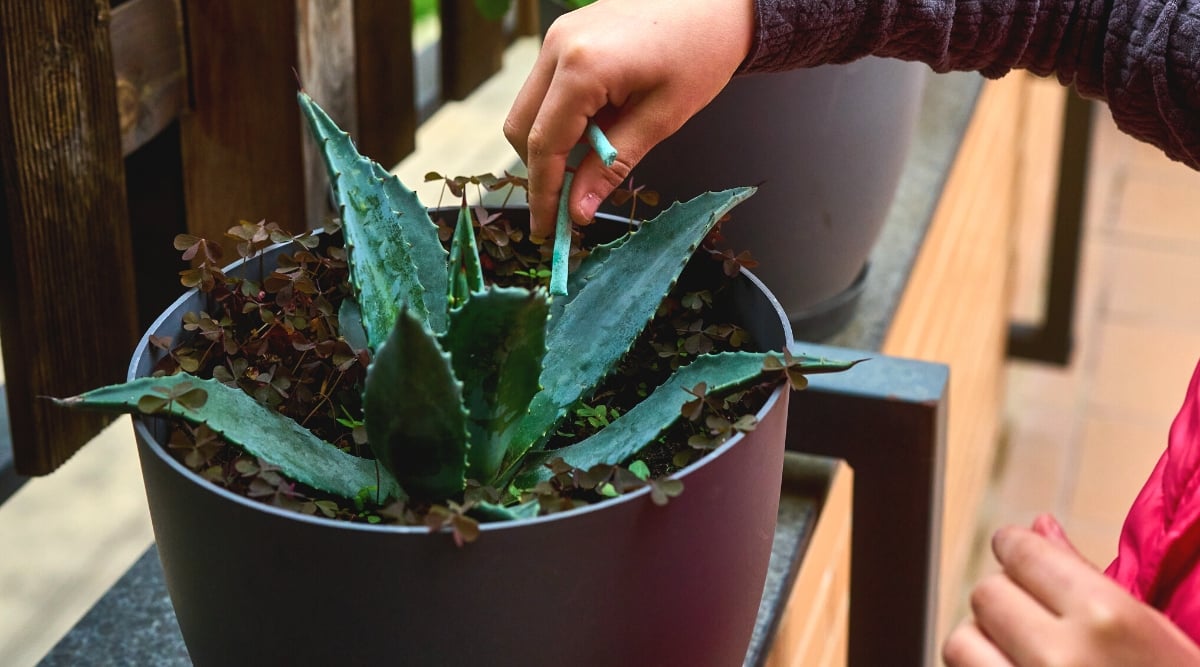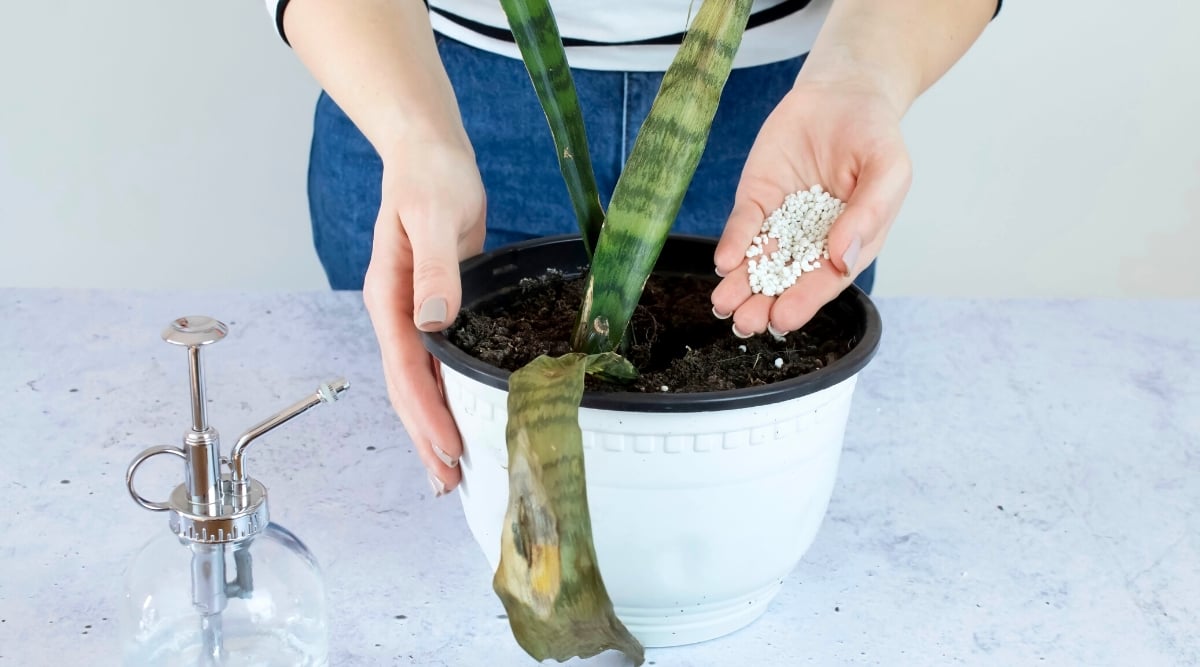There are a couple of plant care basics that all gardeners consider day to day to keep their plants looking good. Watering is high-priority as it needs to be done more often than other tasks, but fertilizing is another essential that shouldn’t be forgotten.
But if you’re growing succulents, there is some confusion around best care practices. Since they are so low-maintenance and tough, do they even need plant food?
This guide covers all your questions, from myths you’ve probably heard to advice on which fertilizers are best for your succulent plants.
Myths About Fertilizing Succulents
Indoor succulents require less fertility than other houseplants.
Before we get into the details, it’s important to dispel some myths you may have heard about fertilizing succulents.
The most common myth is that they don’t need fertilizing at all. Like many myths, it has some truth, but it’s not quite as simple as it seems. Succulents need less fertilizer than other plants and may not need an additional boost outdoors if you have good-quality soil. But when you’re growing in containers, nutrients will eventually get depleted, and it’s best to replace them, even if it is in limited amounts.
Another myth to ignore, especially if you’re growing succulents indoors, is that these plants need the same amount of nutrients as other houseplants.
Most succulents are accustomed to growing in soil with fewer nutrients and can face damage if they are given too much fertilizer. Half-strength doses at minimal intervals are recommended for most types to give them just enough to grow to their full potential.
There is also the general myth that feeding a plant will make it grow faster or that a struggling plant can be fixed by feeding it. Fertilizer is not a cure-all, and when it comes to succulents, growth problems caused by nutrient deficiency are incredibly unlikely. Feeding also won’t make a slow-growing succulent shoot up quicker than it naturally can. It supplements strong growth but it’s not the only factor involved.
Now that we’ve cleared up some misconceptions, let’s dive into what fertilizer is and why it’s important for your succulents.
Why Fertilizer Is Important
 Plants require macronutrients (NPK), secondary nutrients, and micronutrients.
Plants require macronutrients (NPK), secondary nutrients, and micronutrients.
Fertilizing is an important part of plant care, along with basics like watering and maintenance. All plants need certain nutrients to grow and stay alive, just like humans do. These nutrients are present in the soil and get drawn up by the roots through water, transported to the parts of the plant that need it.
Nutrients are generally split into three categories:
- Macronutrients (NPK)
- Secondary Nutrients
- Micronutrients
The first is macronutrients – nitrogen, phosphorus, and potassium. You will recognize these letters as NPK on product packaging.
Secondary nutrients are things like calcium that plants need in moderate amounts but not as much as the macronutrients.
Finally, there are micronutrients like iron. These are needed in much smaller amounts but play a vital role in overall plant health.
Having the right balance of these groups in your soil will help your plants grow to the best of their ability. The roots will draw up these nutrients over time, eventually depleting the supply if nutrients are not replaced naturally.
Fertilizer is designed to maintain the perfect amount of nutrients in the soil (which differs depending on what you are growing) to help plants grow to their full potential. This is especially important when growing plants in containers, as there is limited soil and nutrients for the plants to access.
Do All Succulents Need Fertilizer?
 The fertility needs of succulents vary depending on soil nutrients and whether they are planted outdoors or in containers.
The fertility needs of succulents vary depending on soil nutrients and whether they are planted outdoors or in containers.
The question of whether all succulents need fertilizer or not is not really a standard yes or no. All succulents need nutrients to grow, but the level of nutrients present in the soil will determine whether they need an extra boost.
Succulents are also not a single group. There is plenty of variety and diversity of succulents across families, genera, and even species. These differences play a role in how much fertilizer to apply or whether to apply fertilizer at all.
However, as a general rule, succulents planted outdoors typically don’t require extra feeding. As long as they are planted in healthy soil with plenty of activity, they can typically survive without an extra boost. That’s not to say you shouldn’t fertilize, but that they will usually be fine without it.
Succulents in containers are a different story. Soil is limited, and unless you repot frequently, your succulents will eventually lack the nutrients they need. They may not show signs of struggle, but they also won’t grow as well as they could be with the optimal amount of nutrients in the soil.
An “it depends on the situation” answer isn’t really satisfying. But if you’re on the fence (and stay aware of the risks of overfertilizing), a little extra boost of the right product is better than no feeding at all.
Fertilizing Succulents Indoors Vs Outdoors
 Outdoor succulents grow faster, and may need more frequent fertilization.
Outdoor succulents grow faster, and may need more frequent fertilization.
Although I’m not a fan of growing succulents indoors year-round, many people have the ideal spot for an abundant indoor succulent garden. For those gardeners, you may wonder whether there is a difference between fertilizing succulents indoors vs outdoors.
Again, it depends on your specific plants. Succulents outdoors typically grow quicker and stronger than succulents indoors, potentially requiring feeding sooner or more often.
I recommend fertilizing indoor succulents only once per year, while those outdoors in containers can usually handle an extra fertilizing session or two throughout the warmer seasons.
It’s up to you to assess the performance of the plant and the health of your soil to decide what’s best.
Types of Fertilizer
 Synthetic fertilizers provide quick results but lack soil improvement.
Synthetic fertilizers provide quick results but lack soil improvement.
There are so many different types of plant foods to choose from and it can be difficult to decipher the difference between them. Between organic and synthetic, compound or slow release, there are a few terms to understand before picking the right option.
First, let’s look at organic and synthetic. Organic fertilizers are derived from plants or animals and slowly add nutrients to the soil over time as the organic molecules break down. Some common examples include seaweed-based fertilizer or ‘weed teas’ made from broken-down plants.
Synthetic fertilizers are created to contain a certain amount of nutrients plants need to grow in different ratios. They deliver quicker results but don’t contribute to soil health the way organic fertilizer does.
Both organic and synthetic fertilizers are available in different product types. You may find compound nurients as liquids, granules, or pellets with different application requirements and concentrations. Slow-release fertilizers are designed to degrade over time, slowly adding nutrients to the soil as they break down.
Which Type Of Fertilizer Is Best For Succulents?
 Avoid excessive use of slow-release fertilizers to prevent root burns.
Avoid excessive use of slow-release fertilizers to prevent root burns.
Luckily, when it comes to growing succulents, the plants are not too fussy about the type of fertilizer they get. Most are happy with a balanced fertilizer applied in any form, as long as it is applied according to the packaging instructions. If you’re worried about overfertilizing, avoid slow-release fertilizers as they will burn the roots if applied excessively and are difficult to remove from the soil.
Depending on your chosen product, I usually start with a half-strength dose for most types to avoid overdoing it. Succulents don’t need high levels of soil nutrients and prefer less fertility over an excessive amount.
A fertilizer with equal NPK values is suitable and great for several plants, especially indoors. Alternatively, you can look for a fertilizer slightly higher in phosphorus. Excess nitrogen should be avoided as this can cause growth to become leggy.
There are many specially formulated products for succulents and cacti. Using these will eliminate the guesswork of whether you’re using the right stuff. But I like to work with what I have and take a trial-and-error approach, never applying more than the plants need.
How Often Do Succulents Need Fertilizer?
 Low-concentration fertilizer can be applied more frequently, monitoring for signs of overfertilization.
Low-concentration fertilizer can be applied more frequently, monitoring for signs of overfertilization.
As succulents don’t require a lot of feeding to grow well, I generally restrict my succulent feeding to around once per year. This differs depending on the plants and the size of the container. However, this is usually enough to keep the plants happy without overdoing it.
I also avoid feeding if I’ve recently repotted, as the new soil usually contains enough nutrients. Fertilizing too soon after a soil change may contribute to root stress.
You can apply fertilizer more often if you’re using a low concentration and watch carefully for signs of overfertilizing. For example, I like to fertilize my aloe veras once more in summer to give them a boost before flowering in fall. Once per year is often plenty and provides a far better outcome than fertilizing too much.
When Is The Best Time To Fertilize Succulents?
 Fertilize once a year in early to mid-spring to promote growth, avoiding fall and winter cold damage.
Fertilize once a year in early to mid-spring to promote growth, avoiding fall and winter cold damage.
If you’re fertilizing annually, early to mid-spring is usually the best time. It’s good to encourage growth when temperatures have warmed. New and vulnerable growth is extra sensitive to cold damage in fall and winter.
If you’re adding an extra dose, aim for around two to three months after the first application, around mid-summer. Don’t feed too close to any predicted temperature drops, especially if your succulents are growing outdoors unprotected from the cold.
How To Apply
 Avoid applying fertilizer to leaves, focusing on the soil around the plant.
Avoid applying fertilizer to leaves, focusing on the soil around the plant.
The right fertilizer application method will depend on which product you’ve chosen. Luckily, most product packaging includes a handy guide on exactly how to apply it. Follow these instructions to the tee to avoid any risks of over-fertilizing or wasting the nutrients.
Time your feeding to coincide with watering. Nutrients are drawn up by the roots through water, so the soil should be moist before adding plant food. This also limits your risk of burning the roots by evenly distributing the product throughout the soil.
It’s important to avoid applying the fertilizer to your succulent leaves. Depending on the product you’re using, this can lead to burning. Focus the liquid or granules on the soil around the plant only. Also, keep them away from the stem. Add nutrients to the soil around the plant rather than directly on the plant.
If your succulent container is packed tight, it can be difficult to fertilize the soil directly. Firstly, you should probably consider repotting at some point. But if you like your succulents compact and confined, fill a container with diluted fertilizer and water. Then place the pot inside to allow the soil to draw up moisture from the bottom.
Final Thoughts
If you’re worried about the performance of your succulents, fertilizer can give your plants a much-needed extra boost. It’s not always necessary and certainly isn’t required in large amounts, but adding this simple task to your annual schedule will deliver the best growth possible.



